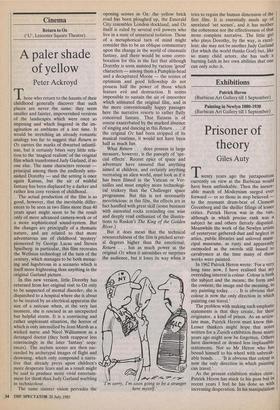Cinema
Return to Oz (`U', Leicester Square Theatre)
A paler shade of yellow
Peter Ackroyd
Those who return to the haunts of their childhood generally discover that such places are never the same: they seem smaller and fainter, impoverished versions of the landscapes which were once so imposing and which lingered in the im- agination as emblems of a lost time. It would be stretching an already romantic analogy too far to suggest that Return to Oz carries the marks of thwarted infantil- ism, but it certainly bears very little rela- tion to the 'magical realism' of the original film which transformed Judy Garland, if no one else. The same characters reoccur principal among them the endlessly asto- nished Dorothy — and the setting is once again Kansas, but the air of wishful fantasy has been displaced by a darker and rather less cosy version of childhood.
The actual production of the film is so good, however, that the inevitable differ- ences to be seen in two films more than 40 years apart might seem to be the result only of more advanced camera-work or of a more sophisticated sound-system. But the changes are principally of a thematic nature, and are related to that more adventurous use of childhood 'mystery' pioneered by George Lucas and Steven Spielberg: in particular, this film recreates the Wellsian technology of the turn of the century, which manages to be both menac- ing and lugubrious in a scenario which is itself more frightening than anything in the original Garland picture.
In this new version, little Dorothy has returned from her original visit to Oz only to be suspected of mental disorder; she is dispatched to a hospital where she is about to be treated by an electrical apparatus the size of a suitcase when, at the very last moment, she is rescued in an unexpected but helpful storm. It is a convincing and rather unpleasant situation, the horror of which is only intensified by Jean Marsh as a wicked nurse and Nicol Williamson as a deranged doctor (they both reappear less convincingly in the later 'fantasy' sequ- ences). The asylum scenes are then suc- ceeded by archetypal images of flight and drowning, which only compound a narra- tive that already preys upon children's more desperate fears and as a result might be said to produce more vivid entertain- ment for theni than Judy Garland warbling in technicolour.
The same sinister vision pervades the
opening scenes in Oz: the yellow brick road has been ploughed up, the Emerald City resembles London dockland, and Oz itself is ruled by several evil powers who live in a state of unnatural isolation. Those of a metaphorical turn of mind might consider this to be an oblique commentary upon the change in the world of cinematic fantasy, and there would be some corro- boration for this in the fact that although Dorothy is soon assisted by various 'good' characters — among them a Pumpkin-head and a decapitated Moose — the scenes of optimism and good fellowship do not possess half the power of those which feature evil and destruction. It seems impossible to sustain the air of innocence which animated the original film, and in the more conventionally happy passages here the narrative resorts to rather flatly conceived fantasy. That, flatness is of course exacerbated by the marked absence of singing and dancing in this Return . . .: if the original Oz had been stripped of its musical routines, it would not have been half as much fun.
What Return . . . does possess in large measure, however, is the panoply of 'spe- cial effects'. Recent epics of space and adventure have ensured that anything aimed at children, and certainly anything recreating an alien world, must look as if it has been filmed in the Vatican or Ver- sailles and must employ more technologi- cal trickery than the Challenger space programme. But this is not necessarily meretricious: in this film, the effects are in fact handled with great skill (some business with animated rocks reminding one wise and deeply read enthusiast of the illustra- tions to Ruskin's The King of the Golden River.) But it does mean that the technical resourcefulness of the film is pitched sever- al degrees higher than the emotional; Return . . . has as much power as the original Oz when it astonishes or surprises the audience, but it loses its way when it `I'm sorry, I'm soon going to be a stranger here myself.' tries to regain the human dimension of the first film. It is essentially made up of unrelated 'set scenes', and it has neither the coherence nor the effectiveness of that more complete narrative. The little girl who plays Dorothy, by the way, is excel- lent: she may not be another Judy Garland (for which the world thanks God) but, like so many child actors, she has such a burning faith in her own abilities that one can only echo it.


















































 Previous page
Previous page